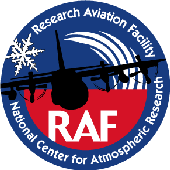
Earth Observing Laboratory (EOL)
Research Aviation Facility (RAF)

|

|
Introduction
Survey
Activities
Data
Useful Publications
HIAPER Inlet Development
Contacts
Atmospheric measurements from an aircraft can be influenced by airflow distortion from the aircraft itself. Movement of air around the aircraft fuselage can impact not only flow speed and direction, but also the concentrations of various constituents being measured. In particular, distortion of certain sizes of particles can generate errors that are larger than those inherent in the sensor measurement itself.
We are developing our airflow modeling effort at the RAF in order to improve sampling from the NSF/NCAR aircraft. We also hope that our results will be useful for broader community needs as well. The present effort is a continuation of work started about ten years ago at the RAF. Substantial progress was made then in characterizing the Electra and King Air aircraft. Recent advances in computational fluid dynamics (CFD) have produced more powerful and efficient tools for airflow analysis. We now seek to apply these new tools to the C-130Q and to the new HIAPER aircraft (a Gulfstream-V, scheduled for delivery in late 2004). We also plan to devise measurements in order to validate model results.
You may wish to read the following overview document:
"Airflow Issues Affecting Airborne Instrumentation Accuracy"
MicroSoft Word format
Adobe Acrobat (pdf) format
In early 2003, we designed a survey to help us identify the most pressing community needs and instrumentation interests. Scientists representing a wide range of areas and facilities responded, demonstrating the strong interest in airflow work. A detailed summary of survey responses can be found here in Adobe Acrobat (pdf) format.
Airflow studies relevant to HIAPER have already begun in collaboration with Gulfstream Aircraft Corporation. Airflow and particle trajectory data are complete for a 40,000 ft case and are summarized in the Twohy, et al. presentation from the HIAPER Instrumentation Workshop. These results have already been used in selecting fuselage and wing sampling locations which will be part of the modifications to the G-V aircraft for sampling. Boundary layer data are also available. With Gulfstream, we will continue to use airflow analysis to identify a suitable pod(s) to carry equipment on the G-V wing.
Once these immediate HIAPER needs are met, RAF is planning to develop computational meshes of parts of HIAPER and the C-130Q using either Fluent or STAR-CD. EOL has already acquired both leading commercial codes (Fluent and Star-CD mentioned above) and is beginning to learn how to use them. In February 2003, Cynthia Twohy, Dave Rogers, Dick Friesen and Jørgen Jensen of NCAR worked with Philippe Nacass from Meteo-France to learn more about the use of Fluent for airflow simulations. EOL Design and Fabrication Services staff were also involved. We hope that this successful collaboration, and others with the European Fleet for Airborne Research, will continue in the future.
DataAirflow information for More to come!Useful PublicationsHIAPER Inlet DevelopmentContactsCynthia Twohy |

Pressure contours around the C-130 wing courtesy of Derek Straub (Click for larger image.) |